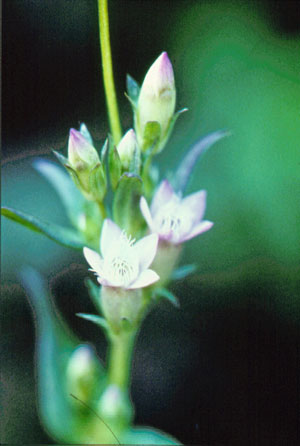DACF Home → Bureaus & Programs → Maine Natural Areas Program → Communities, Plants, and Animals → Rare Plants → Gentianella amarella

Gentianella amarella (L.) Boerner ssp. acuta (Michx.) J. Gilbert
Northern Gentian
- State Rank: S1
- Global Rank: G5T5
- State Status: Endangered
Habitat: Damp turf, gravel, beaches dunes, wet rocks. [Non-tidal rivershore (non-forested, seasonally wet)]
Range: Labrador to Alaska, south to northern Maine, northern Vermont, northern Minnesota, South Dakota, New Mexico, and California.
Aids to Identification: Gentianella amarella is easy to overlook except when in flower. The stem is thin and 15 cm or less high; the leaves small, opposite, entire, and narrowed to the apex. The entire plant may blend into the surrounding vegetation. When flowering, it can be spotted by the clusters (at the top of the plant) of pale purple flowers which, not surprisingly, look like a miniature fringed gentian except with five petals. The petals are fringed not at their tips but rather at the throat of the corolla-tube.
Ecological characteristics: In Maine, the northern gentian is restricted to the shores of the St. John and Aroostook Rivers, where it grows on shifting, seepy, gravelly banks. Until 1981, the plant had not been seen here since 1940, so little is known about its ecology, the persistence of stations, or specific habitat characteristics. At one known location, it grows on the leading edge of the riverbank, very susceptible to being swept away by ice, associated with Pedicularis furbishiae, Alnus viridis ssp. crispa, Fragaria virginiana, etc. The plants appear in different locations within this stretch of habitat from year to year.
Phenology: An annual, flowers in mid to late August in Maine.
Family: Gentianaceae
Synonyms: Amarella acuta (Michx.) Raf.; Gentiana acuta Michx.; Gentiana amarella L. ssp. acuta (Michx.) Hultén; Gentiana amarella L. var. acuta (Michx.) Herder; Gentiana amarella L. var. stricta (Griseb.) S. Wats.; Gentianella acuta (Michx.) Hiitonen; Gentianella amarella (L.) Boerner var. acuta (Michx.) Herder.
Known Distribution in Maine: This rare plant has been documented from a total of 7 town(s) in the following county(ies): Aroostook.
Reason(s) for rarity: Southern limit of range, and calcareous river habitat naturally scarce.
Conservation considerations: Known populations are small, and subject to the vagaries of small populations like random fluctuations or localized disturbance events. Because this is an annual or biennial, conservation depends on maintenance of suitable habitat along the river, not on protection of certain spots.